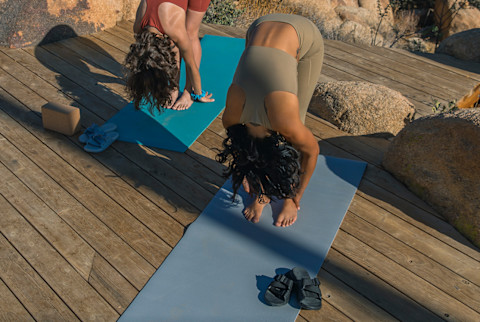Wanting To Build Strength? Don't Skip These 2 Science-Backed Practices

mbg moves
While I enjoy the afterburn of intense workouts, I often need to remember the benefits of slowing down. This week's newsletter offers inspiration for balancing your exercise routine, along with some top-notch editor's picks and dietitian-approved recipes to fuel your active lifestyle.
----------------------------------------------------------------
Stability & stretching support strength
Strength is the cornerstone of health aging, but it doesn’t exist in a silo. If you’re used to pushing hard all the time, mobility, stretching, and balance training might feel a little too “slow.” Trust me, though—they each play a unique role in optimizing performance and reducing injury risk (and they get more critical as we age). Studies consistently show that these elements can improve movement efficiency, joint health, and overall stability:
- Stretching and mobility exercises increase joint range of motion and muscle flexibility, which can help prevent strains, joint pain, and overuse injuries.
- One study found1 that a structured stretching intervention resulted in a 66% reduction in muscle and tendon injuries and a 67% reduction in muscle strains and low back muscle injuries compared to the control group.
- Regular balance exercises improve neuromuscular control and joint stability. One meta-analysis found that balance training alone can reduce ankle injury risk by up to 42% in athletes.2
- Balance training has also been found to enhance physical fitness and performance in athletes, showing up as improved balance, power, agility, and stability.
Verdict? It’s worth the hype. Incorporating mobility, stretching, and balance work into your training routine is a science-backed strategy for safer, more effective workouts.
+Back in balance
- Get stronger bones, joints, & muscles with these 3 expert tips
- Balance better in just 12 minutes with this routine
- Is this the best-kept longevity secret?
---------------------------------------------------------------
Dishing it out
- High-protein one-pot dinner alert (hint: it involves chicken)
- A fluffy baked omelet with anti-inflammatory spices for days
- This vanilla raspberry chia pudding has 35+ grams of protein
- 3 meals to make post-workout & how to hydrate
---------------------------------------------------------------
Today’s Top 3
When you train regularly, you can feel the difference in your body. But I often wonder how movement—along with sleep, nutrition, and other well-being practices—are impacting my longevity long-term.
That’s why I’m a huge fan of using wearables. These devices give important insights on a variety of longevity stats to help you see how everyday changes impact your well-being.
What I track:
- Lifespan: WHOOP’s newest device uses max heart rate, VO2 max, daily steps, lean body mass, sleep, and time spent in Zone 1-3 and 4-5 to estimate your average lifespan—so you can see how your daily workouts impact your longevity.
- Steps, Sleep, & Blood Sugar: Oura’s newest design is their best activity tracker yet! The new release tracks closer to other fitness devices (like WHOOP!) and I’m a huge fan of the new Stelo integration for blood sugar monitoring.
- Running, Swimming, & More: The Venu 2 has more than 30 built-in sports apps to support a variety of activities—including GPS for runners. When movement is your top focus, Garmin is a budget-friendly pick.
—Braelyn Wood, deputy commerce editor
---------------------------------------------------------------
Full-Body Balance & Strength
This quick 12-minute workout helps you home in on balance and strength, two key areas of functional fitness to keep you pushing your limits year after year. Add it to your daily workout routine and feel free to pick up heavier weights for a bigger burn.
+It’s all about balance
- New to working on your balance? Try this
- It all starts with your feet
- Mobility & recovery practices that PTs swear by
